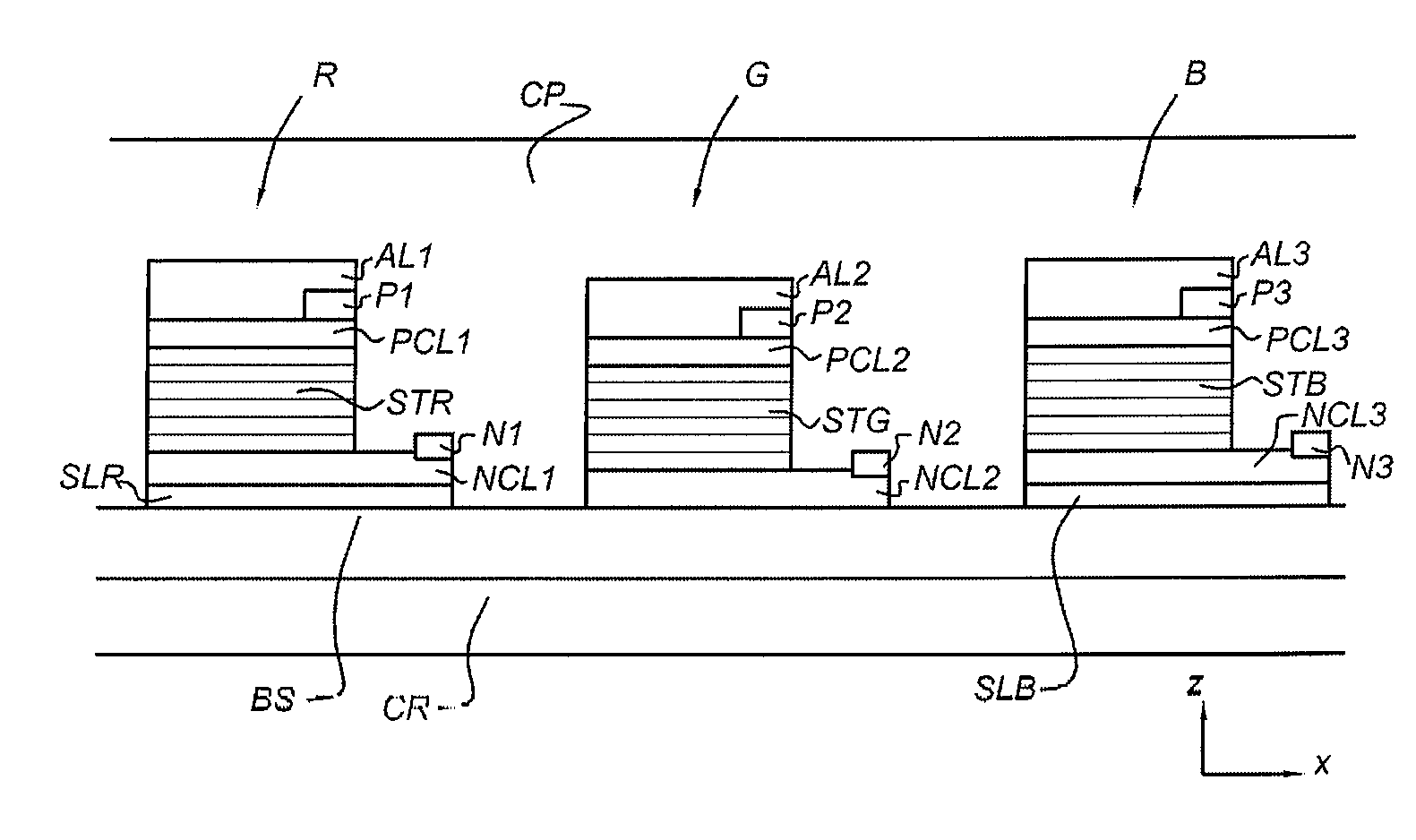Light-emitting diode arrays and methods of manufacture
a technology of light-emitting diodes and arrays, which is applied in the direction of spectral modifiers, solid-state devices, lighting and heating apparatus, etc., can solve the problems of front-of-screen performance and lcd displays are still inferior to conventional crt displays
- Summary
- Abstract
- Description
- Claims
- Application Information
AI Technical Summary
Benefits of technology
Problems solved by technology
Method used
Image
Examples
first embodiment
[0041]FIG. 2 shows schematically a cross-section of an LED stack arrangement. The cross-section extends along the horizontal direction X.
[0042]A base substrate BS is arranged on a carrier plate CR. The carrier plate CR has the function of being a carrier of the LED array(s) and usually may not have a required surface condition which allows forming a suitable semiconductor stack for each type R, G, B of LED element.
[0043]Thus, on top of the carrier plate CR the base substrate is arranged as an interfacial layer for each type of LED element in such a way that the interfacial layer provides substantially the required or acceptable surface condition for a type of LED element. The carrier plate CR may therefore require a treatment in order to be able to carry a base (monocrystalline) substrate BS like silicon (Si), sapphire, silicon-carbide (SiC) or gallium-arsenide (GaAs), depending on the particular semiconductor stack desired for a specific sub-pixel.
[0044]In this embodiment, the base...
second embodiment
[0057]FIG. 3 shows schematically a cross-section of a LED stack arrangement. In FIG. 3, entities with the same reference number as in the preceding figures refer to the corresponding entities.
[0058]In this embodiment, different LED elements (that is, LEDs with different semiconductor stacks) are formed on the base substrate by providing a precursor layer or adhesion layer between the base substrate and the respective semiconductor stack. In the example shown here, the base substrate BS is arranged for accommodating one type of LED element directly on the surface BS by providing a specific or acceptable structural correlation with the crystal lattice of the semiconductor stack. For example, the LED element for the green sub-pixel G is grown / formed directly on the base substrate BS. The base substrate BS may provide the specific or acceptable surface condition that allows formation of the LED element with semiconductor stack STG for the green sub-pixel G directly on the base substrate...
third embodiment
[0062]FIG. 4 shows schematically a cross-section of an LED stack arrangement. In FIG. 4, entities with the same reference numbers as in the preceding figures refer to the corresponding entities.
[0063]In this example the LED element for the green sub-pixel G and the LED element for the blue sub-pixel B are formed directly on the base substrate BS. For example, the base substrate BS is specific for the negative contact layer NCL2 and the semiconductor stack ST2 of the green sub-pixel LED element G. The LED element for the green sub-pixel has, for example, an optimal structural correlation with the base substrate BS. The semiconductor stack ST3 of the blue-pixel has a less than optimal match to the base substrate BS, but the light output of the blue-pixel LED element may still be acceptable.
[0064]In this embodiment, the LED element for the red sub-pixel cannot be formed on the base substrate due to an unacceptable mismatch to the base substrate. Therefore, a precursor / adhesion layer SL...
PUM
 Login to View More
Login to View More Abstract
Description
Claims
Application Information
 Login to View More
Login to View More - R&D
- Intellectual Property
- Life Sciences
- Materials
- Tech Scout
- Unparalleled Data Quality
- Higher Quality Content
- 60% Fewer Hallucinations
Browse by: Latest US Patents, China's latest patents, Technical Efficacy Thesaurus, Application Domain, Technology Topic, Popular Technical Reports.
© 2025 PatSnap. All rights reserved.Legal|Privacy policy|Modern Slavery Act Transparency Statement|Sitemap|About US| Contact US: help@patsnap.com



